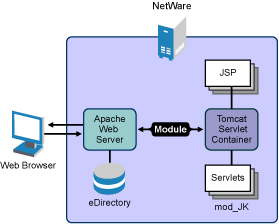1.2 Administration Instance vs. Public Instance of Tomcat on NetWare
As with the Apache Web server, two instances of Tomcat are configured on your server: an administration instance and a public instance. By default, Tomcat is installed to sys:\tomcat. Unlike Apache, which also includes administration and public versions, each installed into their own directories, both instances of Tomcat share the same Tomcat directory. Adding additional instances of Tomcat is a matter of modifying the autoexec.ncf file.
If during the NetWare installation you did not choose to install Tomcat, only the administration instance is installed.
HINT:If you are a developer and you need to add additional instances of Tomcat, see the Novell Developer Kit.
1.2.1 About the Administration Instance of Tomcat
The administration instance of Tomcat is used by NetWare to host and manage Novell services such as Apache Manager and the NetWare Welcome Web site. When requests come to the Apache Web server from any of the NetWare products, Apache identifies requests that require the use of Tomcat. These requests are passed through the mod_jk module on Apache to Tomcat, as shown in the following diagram.
Figure 1-1 Apache and Tomcat Communication

The mod_jk plug-in opens a socket to an instance of Tomcat and communicates with it using the AJP 13 protocol. Tomcat processes the HTTP request and then returns an HTTP response, which is sent back through the same socket connection to Apache. Apache then serves the response up to the client that requested it.
The following table lists key files used by the administration instance of Tomcat and how they are used.
Table 1-1 Tomcat Administration Key Files
1.2.2 About the Public Instance of Tomcat
The second, or public, instance of Tomcat functions as your own dedicated servlet container, which you can optimize and use to host your own Web applications.
The following table lists key files used by the public instance of Tomcat and how they are used.
Table 1-2 Tomcat Public Key Files
|
Key Files |
Purpose |
|---|---|
|
sys:/tomcat/4/bin/tomcat4.ncf |
Use at the system console to start the public instance of Tomcat by entering tomcat4. You can also use tomcat4 stop to stop the server. |
|
sys:/tomcat/4/bin/tc4stop.ncf |
Use at the system console to stop the public instance of Tomcat by entering tc4stop. |
|
sys:/tomcat/4/bin/catalina.pl |
Primarily used as the start and stop script for Tomcat. It is also used for other purposes, such as starting JPDA mode. |
|
sys:/tomcat/4/bin/startup.ncf |
Used during startup to manage NetWare-specific command line parameters. It is used by tomcat4.ncf and tcadmup. |
|
sys:/tomcat/4/conf/server.xml |
Configuration file that contains port number specifications. Ports here must match those found in the workers.properties file. |
|
sys:/adminsrv/conf/mod_jk/workers.properties |
Same file that is used by the administrative instance of Tomcat. See sys:/adminsrv/conf/mod_jk/workers.properties above. |
After reviewing this guide, see the Tomcat documentation on the Jakarta Project Web site.